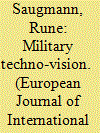|
|
|
Sort Order |
|
|
|
Items / Page
|
|
|
|
|
|
|
| Srl | Item |
| 1 |
ID:
163731


|
|
|
|
|
| Summary/Abstract |
Images taken by civilians and shared online have become an important source of conflict intelligence. This article explores issues around how states and non-state actors appropriate civilians’ images to produce intelligence about conflict, critically scrutinizing a practice often called open source or social media intelligence. It argues that image appropriation for open-source intelligence production creates a new kind of visual security paradox in which civilians can be endangered by their everyday visual practices because their digital images can be appropriated by outside actors as conflict intelligence. The transformation of everyday images into conflict evidence relies on what Barthes termed the photographic paradox, the paradox that while a photograph is clearly not the reality it depicts, the photograph is casually interpreted as a copy of that reality. When images are appropriated as conflict intelligence this photographic paradox translates into a security paradox. A visual security argument can be made without the intention or knowledge of the image producer, who then comes to perform the role on an intelligence agent. Yet civilians in warzones can hardly refrain from producing any images when they need to call attention to their plight, and to stay in contact with friends and relatives. The paradox, then, is that such vital visual signs of life can rapidly become sources of danger for the civilian. This civilian visual security paradox, it is argued, demands that intelligence actors respect the protected status of civilians in their online collection practices. So far, however, there is little sign of such respect.
|
|
|
|
|
|
|
|
|
|
|
|
|
|
|
|
| 2 |
ID:
169162


|
|
|
|
|
| Summary/Abstract |
Military applications of technologies for enhancing or producing vision play a key role in composing contemporary security, as such technologies are deployed to make security sense of everyday sociality, of battlefields, and of much in between these extremes. In this article, I set out to recompose militarised techno-vision through the public detritus left by its heterogenous development, use, and appropriation. I argue that as an heterogenous and amalgamated object, military techno-vision can be composed by speaking the stories of its leftovers, and that this composition is characterised by and in turn characterises a longstanding dilemma between fact and vision – between the ambiguity that is constitutive of the human practices of visual perception and image-making, and the desire for machines that can produce visual ‘actionable intelligence’ that can underpin security decisions. Discourses, practices, and regimes of visibility are deployed alongside technologies to occlude the ambiguity of technological vision and sustain the imaginary of technologically altered vision as neutral production of military or security facts.
|
|
|
|
|
|
|
|
|
|
|
|
|
|
|
|
|
|
|
|
|